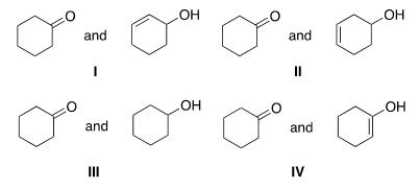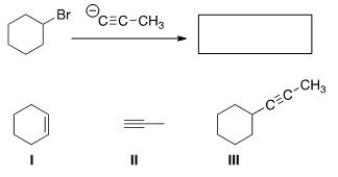A) I
B) II
C) III
D) IV
F) A) and C)
Correct Answer

verified
Correct Answer
verified
Multiple Choice
What is the major organic product of the following reaction?

A) I
B) II
C) III
D) IV
F) A) and D)
Correct Answer

verified
Correct Answer
verified
Multiple Choice
Determine the product of the following reaction. 
A) I
B) II
C) III
D) IV
F) A) and D)
Correct Answer

verified
Correct Answer
verified
Multiple Choice
Which of the following molecular formulas is consistent with the formula for a molecule containing one alkyne and no other degrees of unsaturation?

A) I
B) II
C) III
D) IV
F) B) and C)
Correct Answer

verified
Correct Answer
verified
Multiple Choice
Which of the following statements about the reactions of alkynes is not true?
A) Alkynes contain easily broken p bonds.
B) Alkynes undergo addition reactions.
C) When alkynes undergo two sequential addition reactions, four new s bonds are formed.
D) When alkynes undergo two sequential addition reactions, two new s bonds and a p bond are formed.
F) A) and C)
Correct Answer

verified
Correct Answer
verified
Multiple Choice
In the addition of HBr to 1-butyne, the nucleophile in the first step of the mechanism is:
A) The Csp-H1s bond of 1-butyne.
B) The C-C triple bond of 1-butyne.
C) The H atom in HBr.
D) The Br ion.
F) A) and B)
Correct Answer

verified
B
Correct Answer
verified
Multiple Choice
What is the major organic product of the following reaction?

A) I
B) II
C) III
D) IV
F) B) and C)
Correct Answer

verified
Correct Answer
verified
Multiple Choice
Which of the following bases cannot deprotonate acetylene? You are given the pKa values of the conjugate acids in parentheses. 
A) Only I and II
B) Only I and III
C) Only II and III
D) Only II and IV
F) A) and D)
Correct Answer

verified
Correct Answer
verified
Multiple Choice
Which of the following bases can deprotonate acetylene? You are given the pKa values of the conjugate acids in parentheses. 
A) Only I and II
B) Only I and III
C) Only II and III
D) Only II and IV
F) None of the above
Correct Answer

verified
Correct Answer
verified
Multiple Choice
What is the relationship between the keto and enol forms of acetone, CH3COCH3?
A) Same compounds
B) Diastereomers
C) Enantiomers
D) Constitutional isomers
F) B) and C)
Correct Answer

verified
D
Correct Answer
verified
Multiple Choice
Which of the following represents a keto-enol tautomeric pair?

A) I
B) II
C) III
D) IV
F) A) and C)
Correct Answer

verified
Correct Answer
verified
Multiple Choice
Which of the following statements about alkynes is not true?
A) Alkynes undergo many addition reactions.
B) Alkynes are more polarizable than alkenes.
C) Both p bonds of a C-C triple bond are weaker than a C-C s bond.
D) The electrons in the p bonds of alkynes are more tightly held than those of alkenes.
F) A) and C)
Correct Answer

verified
Correct Answer
verified
Multiple Choice
Which of the following statements about tautomers is true?
A) Tautomers differ in the position of a single bond and a hydrogen atom.
B) Tautomers differ in the position of a double bond and a carbon atom.
C) Tautomers differ in the position of a double bond and a hydrogen atom.
D) Tautomers differ in the position of a single bond and a carbon atom.
F) None of the above
Correct Answer

verified
Correct Answer
verified
Multiple Choice
Which of the indicated hydrogen in the following compounds is the least acidic?

A) I
B) II
C) III
D) IV
F) A) and D)
Correct Answer

verified
Correct Answer
verified
Multiple Choice
Which of the following anions is the most basic?

A) I
B) II
C) III
D) IV
F) None of the above
Correct Answer

verified
Correct Answer
verified
Multiple Choice
In the addition of HBr to 1-butyne, the electrophile in the first step of the mechanism is:
A) The Csp-H1s bond of 1-butyne.
B) The C-C triple bond of 1-butyne.
C) The H atom in HBr.
D) The Br ion.
F) None of the above
Correct Answer

verified
C
Correct Answer
verified
Multiple Choice
What is (are) the major organic product(s) of the following reaction?

A) Only I and II
B) Only II and III
C) Only I and III
D) I, II, and III
F) A) and C)
Correct Answer

verified
Correct Answer
verified
Multiple Choice
Which method would work the best in accomplishing the following transformation?
![Which method would work the best in accomplishing the following transformation? A) [1] HBr; [2] 2eq.NaNH<sub>2</sub> B) [1] Br<sub>2</sub>; [2] 2eq.NaNH<sub>2</sub> C) [1] Br<sub>2</sub>, H<sub>2</sub>O; [2] NaNH<sub>2</sub> D) [1]BH<sub>3</sub>, THF; [2] H<sub>2</sub>O<sub>2</sub>, NaOH; [3] NaNH<sub>2</sub>](https://d2lvgg3v3hfg70.cloudfront.net/TB5872/11eb4ad7_6c26_faa4_99b2_d9d976e16768_TB5872_00.jpg)
A) [1] HBr; [2] 2eq.NaNH2
B) [1] Br2; [2] 2eq.NaNH2
C) [1] Br2, H2O; [2] NaNH2
D) [1]BH3, THF; [2] H2O2, NaOH; [3] NaNH2
F) C) and D)
Correct Answer

verified
Correct Answer
verified
Multiple Choice
Rank the following compounds in order of decreasing basicity, putting the most basic first. 
A) I > II > III
B) III > II > I
C) III > I > II
D) II > III > I
F) A) and C)
Correct Answer

verified
Correct Answer
verified
Multiple Choice
Which of the indicated hydrogen in the following compounds is the most acidic?

A) I
B) II
C) III
D) IV
F) None of the above
Correct Answer

verified
Correct Answer
verified
Showing 1 - 20 of 42
Related Exams